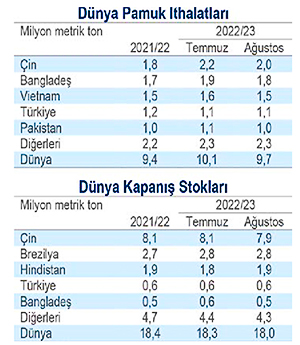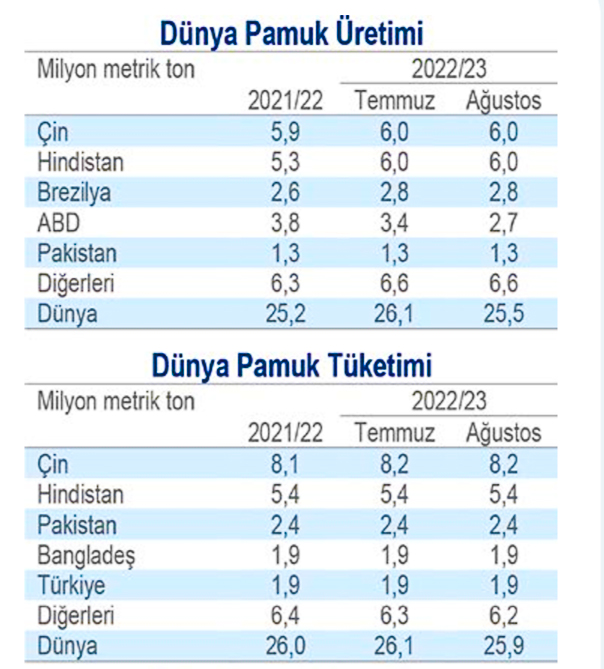Recent price movement
Most benchmark prices rose over the past month.
• After posting a series of solid increases recently, the most actively traded NY/ICE December futures contract rose the limit following the release of the latest USDA supply and demand report (+4.0 cents/lb to 109 cents/lb on August 12th). The string of recent gains represents a sharp reversal relative to the collapse in June and July, when values fell from 120 cents/ lb to as low as 84 cents/lb (July 14th).
• After dropping to 102 cents/lb on July 15th, values for the 2022/23 version of the A Index moved steadily higher and reached 123 cents/lb on August 12th.
• The China Cotton Index (CC 3128B) has been flat in recent weeks, near 106 cents/lb (15,650 RMB/ton). The RMB was also relatively stable against the dollar for most of the past month (near 6.75 RMB/USD).
• Indian spot prices (Shankar-6 quality) increased from 139 to 153 cents/lb in early July and the present. In domestic terms, values rose from levels near 85,000 to 95,500 INR/ candy. The INR was steady near the USD, around 80 INR/USD.
• Pakistani spot prices increased from levels as low as 85 cents/lb near the middle of July. Since then, prices ebbed and flowed, with the latest reading back over 100 cents/ lb. The PKR was volatile against the USD, trading between 240 and 217 PKR/USD over the past month.
Supply, demand & Trade
The latest USDA report featured decreases in global production (-3.1 million bales to 117.0 million) and mill-use (-839,000 bales to 119.1 million) forecasts for 2022/23. Revisions to historical figures lifted beginning stocks +685,000 bales to 84.7 million. The net result for World ending stocks was a -1.5 million bale decrease. The current projection calls for 82.8 million bales of ending stocks in 2022/23. This is the lowest volume since 2018/19, when global ending stocks were 81.5 million bales and the A Index averaged 84 cents/lb. At the country-level, the only change over 100,000 bales was for the U.S., where the forecast plummeted -2.9 million bales to 12.6 million. If realized, this would
be the smallest U.S. crop since 2009/10. With this reduction, the U.S. dropped to the fourth position in the rankings of the world’s largest cotton producers (behind China, India, and now Brazil). The U.S. still ranks as the world’s largest exporter (12.0 million bales forecast, Brazil is expected to export 9.3 million bales in 2022/23). In terms of mill-use, the largest changes to 2022/23 projections included those for the U.S. (-200,000 bales to 2.3 million), Vietnam (-200,000 bales to 6.9 million), Bangladesh (-100,000 bales to 8.5 million), and Turkey (-100,000 bales to 8.5 million). There were also notable updates to figures for 2021/22, which included decreases for India (-500,000 bales to 25.0 million), Pakistan (-100,000 bales to 10.8 million), and Vietnam (-100,000 bales to 6.8 million) as well as a 100,000 bale addition for Turkey (to 8.7 million). The global trade forecast for 2022/23 was lowered -1.8 million bales to 44.6 million. Revisions to import figures were widespread. The largest changes included those for China (-1.0 million bales to 9.0 million), India (-200,000 to 1.5 million), Pakistan (-200,000 bales to 4.8 million), Vietnam (-200,000 bales to 7.0 million), Bangladesh (-100,000 bales to 8.4 million), and Turkey (-100,000 bales to 4.9 million). In terms of exports, the largest updates were for the U.S. (-2.0 million bales to 12.0 million) and Australia (+200,000 bales to 6.2 million).
Price outlook
Cotton prices continue to be caught between the two competing storylines that have been in play for the past several months. On one side, there is the deteriorating global macroeconomic situation. The International Monetary Fund (IMF) lowered its projection for global economic growth in both 2022 (3.2%) and 2023 (2.9%) in the updates released in late July. Current IMF forecasts are significantly beneath those from January (called for 4.4% growth in 2022 and 3.8% growth in 2023) and April (called for 3.6% growth in 2022 and 3.6% growth in 2023). The evolution in the macroeconomy was a likely factor contributing to the shift in investors’ outlook on the commodity sector, which led to a collapse in prices for cotton and a range of other commodities in June and July. Beyond the weakening macroeconomic environment, there also may be factors associated with cotton supply chains that could affect demand during the 2022/23 crop year. Downstream consumer markets for cotton can be viewed as more discretionary than other spending categories, such as food, energy,and lodging, that experienced some of the sharpest effects of inflation. Given price increases for necessities, consumers may have less income to devote to apparel and home furnishings. In the U.S., consumer spending on clothing has been flat for the past year. However, it has been holding at levels that are 25% higher than they were in 2019. If U.S. consumers pull back on clothing purchases, it may hit the market just as retailers have caught up with consumer demand after the onset of the shipping crisis. In weight volume, the cotton contained in U.S. apparel imports was up 22% year-over-year in the first half of 2022. Relative to 2019 (pre-COVID and pre-shipping crisis), the volume in the first half of 2022 was up 23%. Given strong import volumes, if there is a dip in consumer demand, inventory could build both at retail and upstream in supply chains. This could lead to cancelations, potentially all the way back to the fiber level, where contracts signed at prices higher than current values could be particularly susceptible. Tight U.S. supply is on the other side of price direction arguments. Cotton is drought tolerant, and that is why it can be viably grown in perennially dry locations like West Texas. However, cotton requires some moisture to germinate and generate healthy yields. West Texas has had very little rain over the past year, and drought conditions have been extreme. As a result, abandonment is forecast to be widespread. It remains to be seen exactly how small the U.S. crop will be, but the current USDA forecast predicts only 12.6 million bales in 2022/23 (-5.0 million fewer bales than in 2021/22). Meanwhile, demand for U.S. cotton has been relatively consistent, near 18 million bales over the past five crop years (an average of 15.5 million bales of exports and 2.7 million bales of domestic mill-use). A harvest of only 12.6 million falls well short of the recent average for exports alone, and U.S. stocks were near multi-decade lows coming into 2022/23. All these statistics suggest shipments from the world’s largest exporter may have to be rationed in 2022/23. If cotton is not readily available from other sources, the scarcity of supply from the U.S. could support prices globally. Simultaneously, there is weakness from the demand side. The market has struggled to find the balance between the weakened demand environment and limited exportable supply in recent months. The conflict between these two influences makes it difficult to discern a clear direction for prices and suggests continued volatility.















